*Photos by Tiph Browne
Sometimes finding a talented, affordable barber who not only respects your gender identity and presentation, but also really understands your personal style is as difficult as finding clothing that fits. That’s why we like to showcase great barbers and hair stylists recommended by our readers! dapperQ model Nina Kossoff recently recommended Dez Marshall of Nelson’s Barber Shop. So, we sat down with Dez to talk about queer hair, race, gender, and how Nelson’s is creating a safe space for intersectionality.
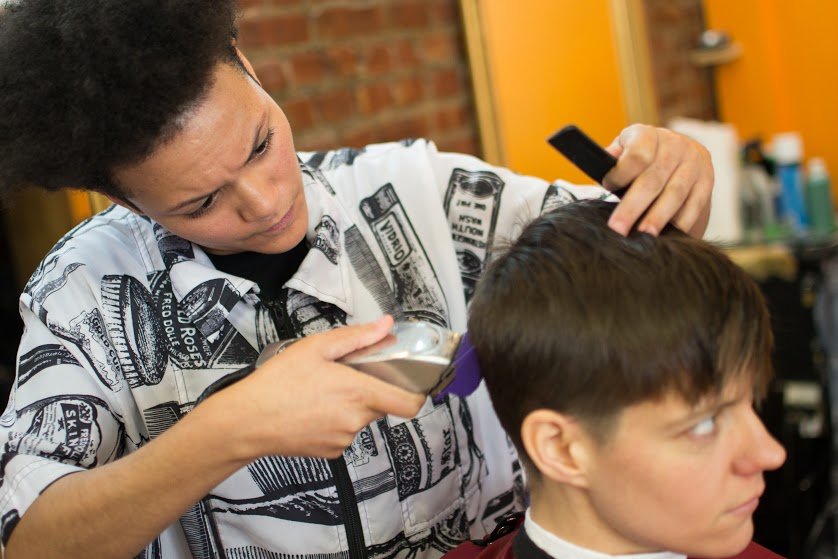
dapperQ: Tell our readers a bit about yourself and Nelson’s Barber Shop.
Dez: Nelson’s Barbershop is located in Flatbush at 248 Parkside Ave. The shop has been in the neighborhood for over 25 years. The current owner, Nelson, has worked there since he was 18 when it was under a different name. He took over approximately 20 years ago. The shop is well known among folks in the neighborhood. It’s an institution really. Most guys have been going there their whole life and once they have their own kids, they start bringing them in to get cuts. There’s a client who moved to Virginia some years ago. He still comes to Brooklyn about once a month for a cut. He isn’t an exception, he is the norm. Barber loyalty is important. Once you find the right barber, not even state lines can keep you apart. The joke is, if you had to choose between your barber or your partner, you would choose your barber.
Nelson’s is primarily a space for men of color to come get a dope haircut. We were voted the Best Place In NYC to Get a Fade or Shave by the Village Voice in 2014. We welcome anyone, regardless of gender expression or race, but Flatbush itself is primarily made up of people of color communities. But even before I started working there, Nelson’s Barbershop had a good sized female clientele. Like almost any other barbershop, we talk sports, movies, politics, current events and women. As a queer woman of color, my opinion is usually very different from others in the shop. We disagree a lot, but I appreciate the honesty. A barbershop is one of the few places that (mostly) men gather and have very honest conversations. It’s really cool to be a part of those conversations.
I have been a barber at Nelson’s since April 2014, but have been cutting hair for about 6 years. I was a community organizer after graduating college. I worked at FIERCE, which organizes queer youth of color in the city. I worked a lot of hours. I didnt always have the money for a cut and definitely didn’t have time to go to a barber. I also had a lot of issues with barbers I did try: they would ask why I wanted to look like a boy, if I wanted “the lesbian haircut” (I still have no clue what this means), or they would ask really invasive questions about my sex life. I eventually found a barber who treated me with respect. Unfortunately, he always cut my skin when he gave me a shape-up, so I would have a scab along my hairline. Eventually I bought my own pair of Wahl clippers, and gave myself caesars. I realized my members probably had similar experiences, so I started to offer free haircuts to them in exchange for participation in meetings, actions, workshops, etc. When I left FIERCE and began working with youth of color at FUREE in Brooklyn, I did the same thing. Eventually, I transitioned out of that field. I had talked for a while about wanting to get my license to practice barbering. In January 2014 I went to the American Barber Institute (ABI), received my Apprentice License, and began working at Nelson’s soon after finishing at ABI. In the next coming months I plan to take my practical exam to receive my Master Barber license. I want to learn the business side of owning and operating a barbershop. My end goal is to own my own shop to serve as a safe space for queer folks to get really dope cuts.
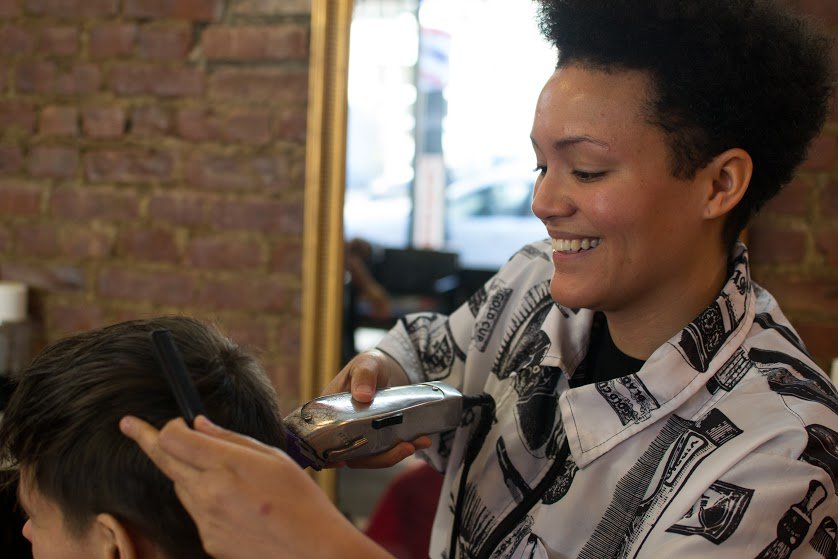
I began offering house and office visits shortly after starting at ABI. I created the ugliest looking flyer ever; It was hideous Microsoft Word art [laughs], then created a better one and started posting on Facebook and passing out flyers at clubs and in Union Square. I wasn’t sure when I would find a chair. The barber industry is very much a boys club. I’ve been at Nelson’s for almost a year and still get men who look at me in disbelief that I am indeed a barber. When I first started, some customers would throw insults, saying I wasn’t a real barber, or that they would never trust a woman to cut their hair. I knew I needed to develop my clientele before I ever started to rent a chair. And I knew I wanted to cater to the queer community, because that is my community. I kept thinking about when I was looking for a barber, and the experiences my members shared with me over the years. We should never be placed in a situation where we have to prove our humanity. But that’s how I felt in a barber chair: That I had to prove I was worthy of service because I didn’t match some idea that the barber had of me. I didn’t come to the shop for your amusement or to satisfy your curiosity. I came for a caesar and shape-up. I knew when I decided to pursue this industry that that would be my hallmark: I will give you a dope cut in a safe space without any judgment of your gender expression or gender identity; I would support it. For many people, their safe space is their home. And being welcomed into that space is something I take very seriously. Being connected to movement spaces, I started offering cuts to those who can open their office as well. Being at a shop offers some levels of convenience, but some people can’t make it to the shop, others want to respect it as a primarily men of color space, others really like the convenience of getting a cut in their home. I try to meet the needs of many folks.
Before I started marketing myself as a barber, I did Spoken Word poetry. I went with the name “dezisdope” (Dez is Dope) because it’s catchy and “dope” is one of my favorite words. A friend of mine made a website that has never been launched. From that site I had a logo. I edited the logo a bit, made a flyer, created some hashtags (#dezisdope #queerwithshears #dezgotskills #madebydopeness #queerbarbersdoitbetter) and started to use Facebook, Twitter and Instagram to get my name out. Folks contact me primarily through email to set up appointments at the shop or for house/office visits. They also message me on Facebook. I do house calls on my days off – Mondays and Tuesdays. House visits are slightly more expensive than the cuts at the shop in order to cover the travel costs.
dapperQ: Do you get many queer customers at Nelson’s?
Dez: Living true to my intention on creating a safe experience for queer and trans folks, I’ve focused my outreach and advertising to these customers as my primary base. I started by just utilizing my personal FB page to support this targeted outreach and then moved to advertising on queer groups on FB, like Queer Exchange and The QTPOC Exchange. I received a bulk of my queer and trans clients this way. While my clientele isn’t exclusively queer and trans, the majority of them are.
dapperQ: Queer fashion sites like dapperQ and Qwear are often asked, “What is queer style?” Does it exist? And, if so, what sets queer style apart from other aesthetics? Along the same lines, many of our readers ask us about queer hair styles (e.g. is there such a thing and where are the best places to get one). Do you believe that “queer hair styles” are a discernible aesthetic? If so, what makes them unique?
Dez: As queer folks, our entire existence challenges hegemonic norms, including our physical forms of expression. I feel like any hairstyle we rock poses a challenge to what society says we are supposed to look like. You rock a fade when society says you should have shoulder-length hair; you have an undercut with a dope design; you have a bowl cut with a tail; maybe you have a classic tapered cut or a funky asymmetrical cut. Or maybe you have the exact cut that society thinks you should have. If you chose it and own it, in my opinion that is a political act of resistance and sustainability. We should be able to look exactly how we want to look. As queer folks, we are told everything about us is wrong, and so as a community I think we take far more risks with our style and push the growing edge more than others. My role as your barber is to allow you to express yourself the way you want.
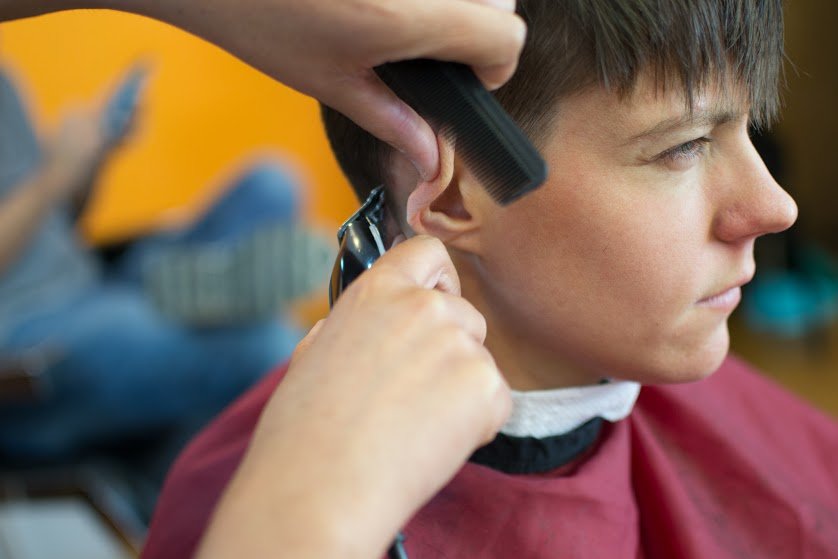
I describe a lot of the cuts I do as “dope” or “funky.” Stark contrasts between weight lines, as opposed to smooth fades. Versatility in how you can style. Unique framing of the face; a playfulness to the cut. Traditionally masculine styles for female-identified clients, traditionally feminine styles for male-identified clients; that’s queer style to me. A barber that is willing to throw out convention is the best barber to go to for these cuts. Barbers are trained to have smooth transitions in our cuts, for everything to be even. To me, queer style flips those ideas. That’s really what I like to do. I play with lengths, I play with weight lines. And I make it look good. It’s a clean look while still being a little messy. It’s perfect, without being perfect. I like to think my cuts have just the right amount of funk with a classic appeal.
dapperQ: How do you understand your clientele different from the way a classic Barbershop does?
Dez: I think working as a community organizer for all those years gives me an advantage that other barbers might not have. As an organizer, your greatest tool is the ability to create strong relationships with people; actively listening and engaging with them in an authentic and genuine way. I definitely bring that to my game as a barber. I listen to my client, not just about the cut they want, but what goes on in their life. Sometimes the conversation is surface: how was your day, are you a fan of whatever team is playing on the tv, how deep is your love for Beyonce, etc. But many times it gets deep: how was it when you came out to family and friends, what are your thoughts on the movement around police brutality, etc. But the conversations are real. They let me connect with my clients and really build with them. On Facebook at least, folks are always looking for a barber. It’s an intimate relationship. Some of Nelson’s clients have been going to him for 20 years. They trust him with a lot of personal info about their lives, family, work, etc. As a barber, you are also a sort of life coach; people tell you things and want your advice. Other times they just want to be heard. My experience as an organizer applies so much to my role as a barber now. It’s not about having the answers to everyone’s problems; it’s about listening and helping them reach the solution themselves. And while they are doing that, helping them look hotter than when they came into the shop. So not only do they feel better because they got something off their chest, or maybe even have a solution to an issue, they look in the mirror and feel good because their haircut is dope.
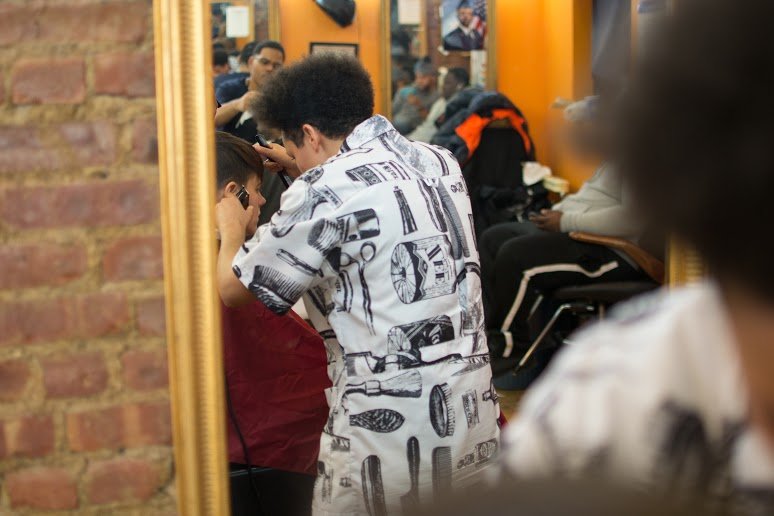
The biggest thing I bring to the table that some other barbers don’t is a shared lived experience with the majority of my clientele. I know how scary it is to be queer, for your gender expression to be different than what others think or expect it to be, and for others to wild out about it. When someone misgenders you, your radar goes up. Your body gets tense because you don’t know what’s going to happen next. I like to think that being an open queer woman of color, I help decrease that type of anxiety at the shop. When a client comes to me, they know they will get a dope cut with support and not judgement. My consultation is thorough, because I want to make sure I am understanding exactly what my client wants, and what they don’t want. This is so important, because a lot of folks will come to me with stories about other barbers they went to who didn’t give them the cut they want. And the person didn’t feel safe enough to challenge them on it. You never want to say to your client, “I thought you said you wanted…” I also take that time to reassure them that they are in a safe space, that I will take care of them, and that they can relax. I don’t start cutting until I know they are ready. There’s comfort in getting your hair cut by another person who is queer and is open about it. I am purposely open about my queerness at the shop, because it is so much a part of my identity. I don’t expect my clients to out themselves in any way. But by me being out, I am putting out the request to the other barbers and clients to maintain the shop as a safe space for me at the very least. And that extends to my clients. It’s definitely not easy. Nelson’s Barbershop is not a magical utopia. I’m willing to bet many of the folks who go there are not around many queer or trans folks. So I have conversations about identity and expression. I share from my own experience what it means to be queer, to be a cisgender woman, to be harassed because of who I am and how I look. And I take a lot of time to discuss words like “trans,” “cisgender, “preferred gender pronouns,” “safe space,” etc. with the other barbers. I have had horrible experiences at some barbershops, and so have my clients. It’s dehumanizing. It’s deplorable. And it shouldn’t happen. When I ask a client what their PGP is (preferred gender pronoun), a lot of the anxiety they had fades away. We share experience, language, horror stories, resistance and empowerment. I am queer barber of color with some radical politics, and I make that known to the shop and anyone that sits in my chair.
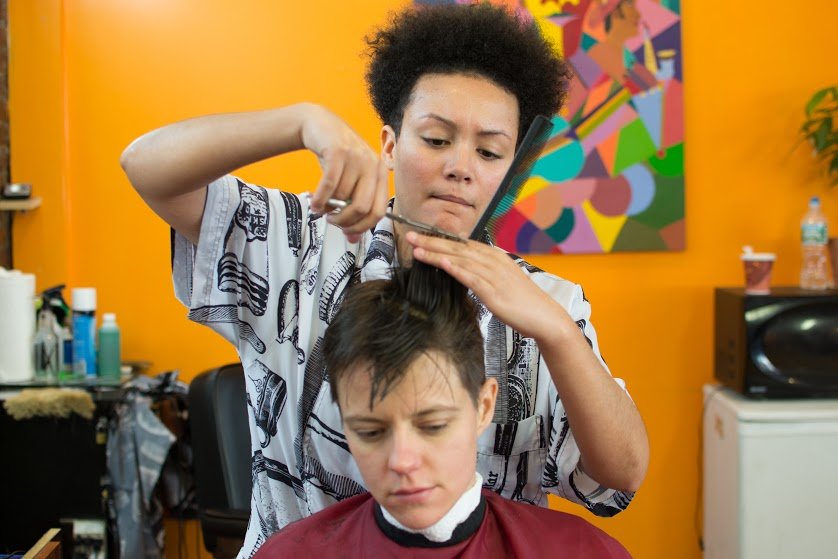
My role is to support my clients in being their full selves. I do that by giving them the haircut they want and treating them with the respect they deserve. I am not sure if that really makes me any different from other barbers, because I think we all do that. But many times, when the barber is not queer and the client is (queer, gender non-comforming, trans), the treatment changes. The simple activity of getting a haircut becomes this intricate and intimidating action. Getting a haircut should be an enjoyable experience. Not one you fear. I reassure people one haircut at a time.
dapperQ: What are your rates?
Dez: The thing I love about Nelson’s Barbershop is that the cuts are affordable, despite the rapid gentrification going on in Flatbush. Our cuts start at $15 cash; a haircut and a shave are $20. My housecall prices start at $20. I provide all the same services in your home that we provide at the shop. As a barber, I specialize in shorter styles: fades, caesars, baldies, undercuts, mohawks, shape-ups. I do a lot of pixie cuts. But I also cut longer hair, mostly in the form of trims. Barbers aren’t trained the same way hairstylists are, so I am not able to style longer hair yet. If you went to a stylist and just need a trim for maintenance, I got you. I also do some design work. I am still learning the ropes of designs, but the more I do it the better I will be.
*Additional info:
If people want to see my cuts, they can visit my fan page on Facebook at facebook.com/dezisdope or they can follow me on Instagram: @dezgotskills.
I am at Nelson’s Barbershop, located at 248 Parkside Ave in Brooklyn:
Wednesdays 9:30am to 9pm
Thursdays-Saturdays 11am to 9pm
Sundays 11am to 9pm
House/Office visits on Mondays and Tuesdays (email to schedule appointment by Sundays at 5pm)
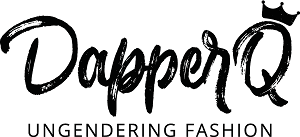

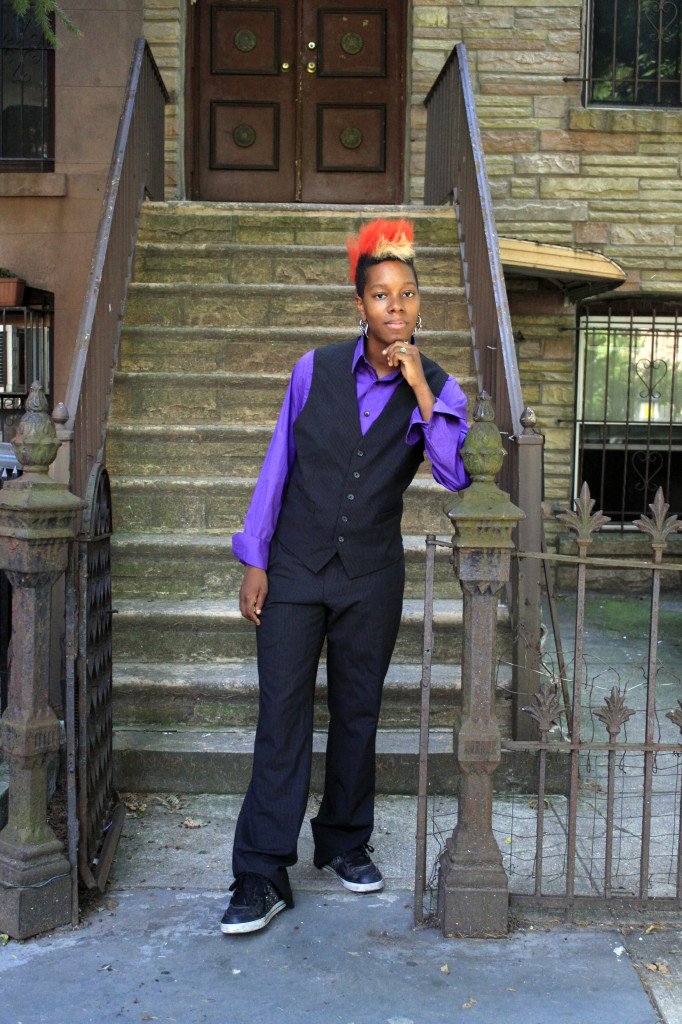
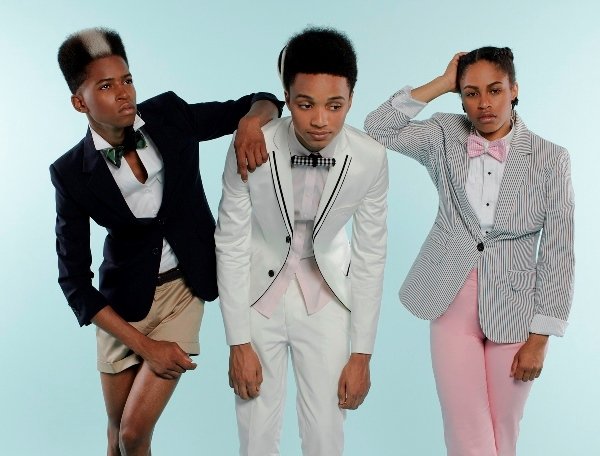

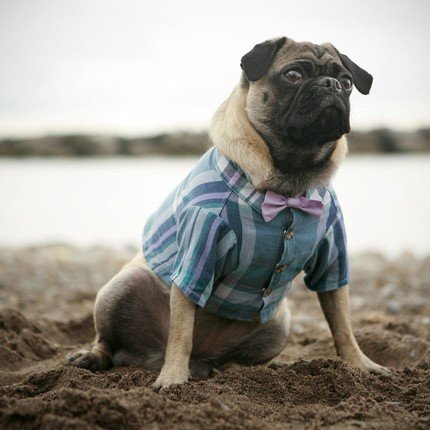
Oh my goodness this is so great! I would love to see more interviewers with rad q/t barbers around the city/country/world.
Loved this interview! Go Dez!!!